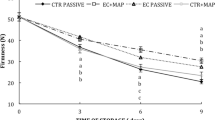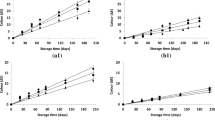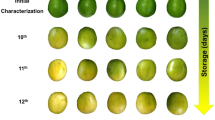Abstract
The aim of this work was to investigate the influence of osmotic dehydration and pectin edible coating on quality parameters of fresh-cut melon. Fruits were osmodehydrated in 40°Bx sucrose solution containing 0.5% calcium lactate or dipped in 0.5% calcium lactate solutions. Then, samples were coated with 1% pectin. Melon pieces dipped in sanitizing solution (nontreated sample) were used as control. Weight loss, respiration rate, firmness, color parameters (lightness, chroma, and whiteness index), sensory acceptance, microbial growth, and structural changes of fruits were evaluated during storage at 5 °C for 14 days. The shelf life of the control sample was limited to 9 days due to microbial growth and sensory rejection, while treated samples showed a shelf life of 14 days. Higher preservation of firmness in coated samples was attributed to the action of calcium salt on melon structure, causing a strengthening of the cell wall. Calcium lactate also inhibited microbial growth along storage, improving microbiological stability of fresh-cut melon. The use of calcium lactate dips and pectin edible coatings hindered weight loss and maintained fruit color characteristics during the storage time. However, these pretreatments probably masked melon taste, reducing the sensory acceptance scores at the end of shelf life study. The combination of osmotic dehydration and pectin coatings was a good preservation alternative for fresh-cut melon, since it improved fruit sensory acceptance, promoting the reduction of product respiration rate, as well as the maintenance of quality parameters during 14 days.






Similar content being viewed by others
References
Aguayo, E., Escalona, V. H., & Artés, F. (2004). Metabolic behavior and quality changes of whole and fresh processed melon. Journal of Food Science, 69(4), 148–155.
Aguayo, E., Escalona, V. H., & Artés, F. (2008). Effect of hot water treatment and various calcium salts on quality of fresh-cut “amarillo” melon. Postharvest Biology and Technology, 47(3), 397–406.
Alandes, L., Hernando, I., Quiles, A., Pérez-Munuera, I., & Lluch, M. A. (2006). Cell wall stability of fresh-cut ‘Fuji’ apples treated with calcium lactate. Journal of Food Science, 71(9), 615–620.
Alves, R.E. (2000). Melon: post-harvest (pp. 1–43). Brasília: Embrapa Comunicação para Transferência de Tecnologia. (In Portuguese).
Bico, S. L. S., Raposo, M. F. J., Morais, R. M. S. C., & Morais, A. M. M. B. (2009). Combined effects of chemical dip and/or carrageenan coating and/or controlled atmosphere on quality of fresh-cut banana. Food Control, 20(5), 508–514.
Bierhals, V. S., Chiumarelli, M., & Hubinger, M. D. (2011). Effect of cassava starch coating on quality and shelf life of fresh-cut pineapple (Ananas comosus L. Merril cv “Pérola”). Journal of Food Science, 76(1), 62–72.
Brazil RDC Resolution No. 12 of 2 January (2001). Technical regulation on microbiological standards for foodstuffs. Brasilia: National Health Surveillance Agency (Ministry of Health/ANVISA). http://www.anvisa.gov.br/legis/resol/12_01rdc.htm/. Accessed 25 Jan 2010.
Castelló, M. L., Igual, M., Fito, P. J., & Chiralt, A. (2009). Influence of osmotic dehydration on texture, respiration and microbial stability of apple slices (var. Granny Smith). Journal of Food Engineering, 91(1), 1–9.
Castelló, M. L., Fito, P. J., & Chiralt, A. (2010). Changes in respiration rate and physical properties of strawberries due to osmotic dehydration and storage. Journal of Food Engineering, 97(1), 64–71.
CEAGESP (2004). Normas de Classificação de Melão (Cucumis melo L.). São Paulo: Programa Brasileiro para Modernização da Horticultura. http://www.ceagesp.gov.br/produtor/classific/fc_melao. Accessed 9 Feb 2009.
Chiumarelli, M., Pereira, L. M., Ferrari, C. C., Sarantópoulos, C. I. G. L., & Hubinger, M. D. (2010). Cassava starch coating and citric acid to preserve quality parameters of fresh-cut ‘Tommy Atkins’ mango. Journal of Food Science, 75(5), 297–304.
Chiumarelli, M., Ferrari, C. C., Sarantópoulos, C. I. G. L., & Hubinger, M. D. (2011). Fresh cut ‘Tommy Atkins’ mango pre-treated with citric acid and coated with cassava (Manihot esculenta Crantz) starch or sodium alginate. Innovative Food Science and Emerging Technologies, 12(3), 381–387.
Downes, F. P., & Ito, K. (2001). Compendium of methods for the microbiological examination of foods. Washington: American Public Health Association.
Eum, H. L., Hwang, D. K., Linke, M., Lee, S. K., & Zude, M. (2009). Influence of edible coatings on quality of plum (Prunus salicina Lindl. cv. ‘Sapphire’). European Food Research and Technology, 229(3), 427–434.
Ferrari, C. C., Carmello-Guerreiro, S. M., Bolini, H. M. A., & Hubinger, M. D. (2010). Structural changes, mechanical properties and sensory preference of osmodehydrated melon pieces with sucrose and calcium lactate solutions. International Journal of Food Properties, 13(1), 112–130.
Garcia, L. C., Pereira, L. M., Sarantópoulos, C. I. G. L., & Hubinger, M. D. (2010). Selection of an edible starch coating for minimally processed strawberry. Food and Bioprocess Technology, 3(6), 834–842.
Lacroix, M., & Le Tien, C. (2005). Edible films and coatings from non-starch polysaccharides. In J. H. Han (Ed.), Innovations in food packaging (pp. 338–361). San Diego: Elsevier Academic.
Lamikanra, O., & Watson, M. A. (2004). Effect of calcium treatment temperature on fresh-cut cantaloupe melon during storage. Journal of Food Science, 69(6), 468–472.
Lee, J. Y., Park, H. J., Lee, C. Y., & Choi, W. Y. (2003). Extending shelf life of minimally processed apples with edible coatings and antibrowning agents. LWT—Food Science and Technology, 36(3), 323–329.
Lewicki, P. P., Gondek, E., Witrowa-Rajchert, A. D., & Nowak, N. (2001). Effect of drying on respiration of apple slices. Journal of Food Engineering, 49(4), 333–337.
Maftoonazad, N., Ramaswamy, H. S., & Marcotte, M. (2008). Shelf-life extension of peaches through sodium alginate and methyl cellulose edible coatings. International Journal of Food Science and Technology, 43(6), 951–957.
Martín-Belloso, O. (2007). Pros and cons of minimally processed foods. Trends in Food Science & Technology, 18(11), 582.
Martín-Diana, A. B., Rico, D., Frías, J. M., Barat, J. M., Henehan, G. T. M., & Barry-Ryan, C. (2007). Calcium for extending the shelf life of fresh whole and minimally processed fruits and vegetables: a review. Trends in Food Science & Technology, 18(4), 210–218.
Meilgaard, M., Civille, G. V., & Carr, B. T. (1999). Sensory evaluation techniques. Boca Raton: CRC.
Moraga, M. J., Moraga, G., Fito, P. J., & Martínez-Navarrete, N. (2009). Effect of vacuum impregnation with calcium lactate on the osmotic dehydration kinetics and quality of osmodehydrated grapefruit. Journal of Food Engineering, 90(3), 372–379.
Olivas, G. I., Mattinson, D. S., & Barbosa-Cánovas, G. V. (2007). Alginate coatings for preservation of minimally processed ‘Gala’ apples. Postharvest Biology and Technology, 45(1), 89–96.
Oms-Oliu, G., Soliva-Fortuny, R., & Martín-Belloso, O. (2008a). Using polysaccharide-based edible coatings to enhance quality and antioxidant properties of fresh-cut melon. LWT—Food Science and Technology, 41(10), 1862–1870.
Oms-Oliu, G., Soliva-Fortuny, R., & Martín-Belloso, O. (2008b). Edible coatings with antibrowning agents to maintain sensory quality and antioxidant properties of fresh-cut pears. Postharvest Biology and Technology, 50(1), 87–94.
Pereira, L. M., Carmello-Guerreiro, S. M., Junqueira, V. C. A., Ferrari, C. C., & Hubinger, M. D. (2010). Calcium lactate effect on the shelf life of osmotically dehydrated guavas. Journal of Food Science, 75(9), 612–619.
Qi, H., Hu, W., Jiang, A., Tian, M., & Li, Y. (2011). Extending shelf-life of fresh-cut ‘Fuji’ apples with chitosan-coatings. Innovative Food Science and Emerging Technologies, 12(1), 62–66.
Raybaudi-Massilia, R. M., Mosqueda-Melgar, J., & Martín-Bellloso, O. (2008). Edible alginate-based coating as carrier of antimicrobials to improve shelf-life and safety of fresh-cut melon. International Journal of Food Microbiology, 121(3), 313–327.
Rico, D., Martín-Diana, A. B., Frías, J. M., Barat, J. M., Henehan, G. T. M., & Barry-Ryan, C. (2007). Improvement in texture using calcium lactate and heat-shock treatments for stored ready-to-eat carrots. Journal of Food Engineering, 79(4), 1196–1206.
Rodrigues, A. C. C., Pereira, L. M., Sarantópoulos, C. I. G. L., Bolini, H. M. A., Cunha, R. L., Junqueira, V. C. A., et al. (2006). Impact of modified atmosphere packaging on the osmodehydrated papaya stability. Journal of Food Processing and Preservation, 30(5), 563–581.
Rojas-Graü, M. A., Tapia, M. S., & Martín-Belloso, O. (2008). Using polysaccharide-based edible coatings to maintain quality of fresh-cut Fuji apples. LWT—Food Science and Technology, 41(1), 139–147.
Serrano, M., Martínez-Romero, D., Castillo, S., Guillén, F., & Valero, D. (2004). Role of calcium and heat treatments in alleviating physiological changes induced by mechanical damage in plum. Postharvest Biology and Technology, 34(2), 155–167.
Soliva-Fortuny, R. C., & Martín-Belloso, O. (2003). New advances in extending the shelf-life of fresh-cut fruits: a review. Trends in Food Science & Technology, 14(9), 341–353.
Tapia, M. S., Rojas-Grau, M. A., Carmona, A., Rodriguez, F. J., Soliva-Fortuny, R., & Martin-Belloso, O. (2008). Use of alginate- and gellan-based coatings for improving barrier, texture and nutritional properties of fresh-cut papaya. Food Hydrocolloids, 22(8), 1493–1503.
Torreggiani, D., & Bertolo, G. (2001). Osmotic pre-treatments in fruit processing: chemical, physical and structural effects. Journal of Food Engineering, 49(2–3), 247–253.
Vargas, M., Pastor, C., Chiralt, A., McClements, D. J., & González-Martínez, C. (2008). Recent advances in edible coatings for fresh and minimally processed fruits. Critical Reviews in Food Science and Nutrition, 48(6), 496–511.
Acknowledgements
The authors would like to thank CNPq (301761/2004-3) and FAPESP (2006/03263-9, 2009/51420-4) for the financial support.
Author information
Authors and Affiliations
Corresponding author
Rights and permissions
About this article
Cite this article
Ferrari, C.C., Sarantópoulos, C.I.G.L., Carmello-Guerreiro, S.M. et al. Effect of Osmotic Dehydration and Pectin Edible Coatings on Quality and Shelf Life of Fresh-Cut Melon. Food Bioprocess Technol 6, 80–91 (2013). https://doi.org/10.1007/s11947-011-0704-6
Received:
Accepted:
Published:
Issue Date:
DOI: https://doi.org/10.1007/s11947-011-0704-6




